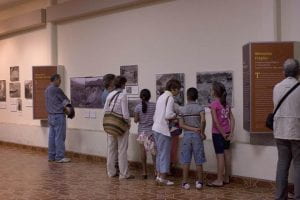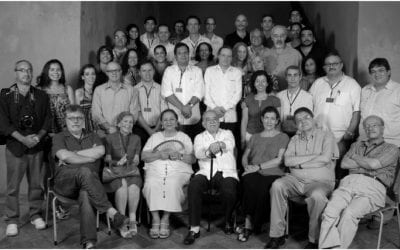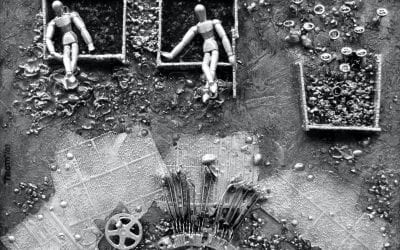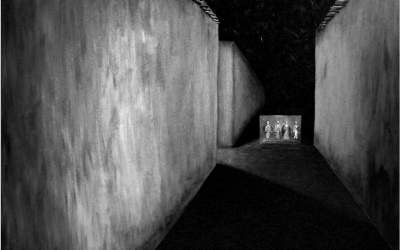Making a Difference: Inheritors of History
A Converstaion with Barbara Fash
The two sandal-clad ten-year-old girls in bobbing ponytails might have been tourists or children on a school excursion. Instead, these enthusiastic youths were explaining the background of the Fragile Memories: Archaeology and Community, Copán, Honduras 1891-1900 exhibit, a collection of 19th century photos housed in the Municipal Palace in Copán Ruinas.
They are part of a team of nine girls and one boy, ranging from 9 to 12 years old, who are trained to show visitors around the exhibit. For these youngsters, it is a lesson in volunteerism and civic participation—but also in their own history and heritage. These images from the 19th century are their history, and Copán Ruinas is their town.
What motivates you about this project?
Developing this docent program has been a wonderful way to work with people that I’ve spent 30 years of my life with, that I’ve raised my children with. This project is all about them as a descendant community that is part of the photographic collection.
How did the exhibit come about?
The idea for the exhibit came about in 2006 when the Peabody Museum was completing a 2 year NEH grant to digitize all of its glass plate negatives from the 19th century. The Copán negatives are the earliest ones, which prompted the Peabody Museum’s Curatorial Board to ask me to consider making an exhibit about them. An important part of the Peabody Museum’s mission is outreach to its descendant communities through exhibitions and collections research, so I agreed to curate the exhibit, but with a return request to them that the museum would donate the exhibition to the town of Copán after it came down.
What did you hope to achieve with the exhibit?
I hope that the exhibit will enable people from Copán to reconnect with their history and visualize the community the way it was in its infancy, and instill in them a sense of civic pride. Reflecting on its history and development will hopefully help people work together to consider what positive future directions they want for their town and move to implement them. The exhibit underscores how the town and the archaeology have always shaped each other, and this process continues today. These young docents are the keepers of the knowledge. We hope more can be done with the school programs and teachers, not just from Copán, but throughout Honduras.
How did the young docent program develop?
I first came upon a young docents program in the cultural center in Gracias, Honduras. Children were explaining the artifacts and the rooms dealing with agriculture and food-making. I thought it was very compelling to see youth so involved and proud of their past.
I took the idea back to Copán. Flavia Cueva, who runs a bed-and-breakfast in Copán and has taught primary school in the United States, was recruited as the project’s promoter. She worked with teachers in the area, who in turn asked for essays from interested students about why they would like to work as docents. Students who wrote the best essays were then interviewed for qualities such as self-assurance.
The docents work from 4-6 p.m. after school, with different children working each day in pairs. We’ve taken them to the ruins and to classes with students in the Harvard Archaeology summer field school. Our archaeology project’s local Community Liason, Karina García, also spent many hours working with the young group. We’re trying to get them beyond reciting the information by rote—to think about their past, which is also their future.
There is a long way to go in developing this program. And there is a lot I am learning too, about how these young people look at their culture and their history.
Spring/Summer 2011, Volume X, Number 2
Barbara Fash is the Director of the Corpus of Maya Hieroglyphic Inscriptions Program. She is the author of The Copan Sculpture Museum: Ancient Maya Artistry in Stucco and Stone (Peabody Museum and David Rockefeller Center for Latin American Studies/Harvard University Press).
Related Articles
New Journalists for a New World
I received a surprising phone call one day in late 1993, when I was the director of Telecaribe, a public television channel in Barranquilla, Colombia. The caller was none other than Gabriel García Márquez. “Will you invite me to dinner?” he asked me. “Of course, Gabito,” I…
Latin American Nieman Fellows
A few days after I arrived at Harvard in August 2000 to begin my work as curator of the Nieman Foundation for Journalism, Tim Golden, an investigative reporter for the New York Times in Latin America, phoned me. “Could I find a place in the new Nieman class for a Colombian…
Freedom of Expression in Latin America
In June 1997, Chile’s Supreme Court upheld a ban on the film “The Last Temptation of Christ,” based on a Pinochet-era provision of the country’s constitution. Four years later, the Inter-American Court of Human Rights heard a challenge to this ban and issued a very different…





